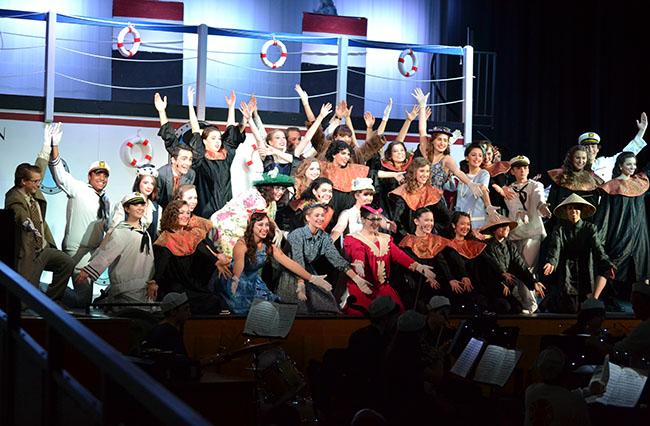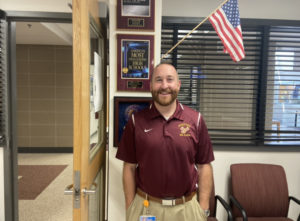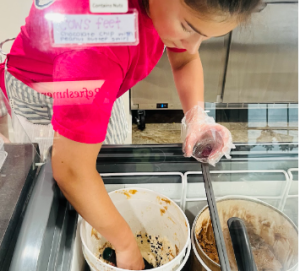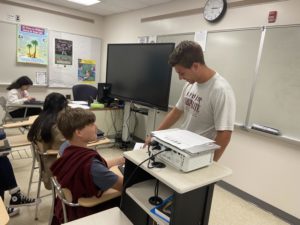Theatre department reveals magic behind shows
The “Anything Goes” cast poses, arms open to the audience, at the end of a full cast dance number on the last night of the show, Dec. 3.
January 4, 2017
“Music and the arts are run by magicians. Magicians work very hard to craft their skills and learn new tricks. You always see the end result. You don’t know how the magic works, and you don’t want to know how the magic works,” Choir and Guitar teacher David Sobel said. “However, the magician spends a lot of time carefully crafting each trick, and covering and maneuvering each small step in order to create an illusion. Musicals are much the same way.”
Students, parents, and friends who attend Hereford’s musicals may not recognize the countless hours of preparation that precede opening night. Fortunately for me, the magicians behind “Anything Goes” were willing to share their secrets. I was granted access behind the scenes of the show on Dec. 3 to document the making of an illusion.
It all begins at call time, the time when all members of cast and crew are required to report to the stage. Fine & Performing Arts Department Chair Chris Rose, along with Sobel, lead the cast through vocal warm ups. Then, all cast and crew join hands in a large circle around the auditorium. After Rose offers some words of encouragement, he initiates the pulse.
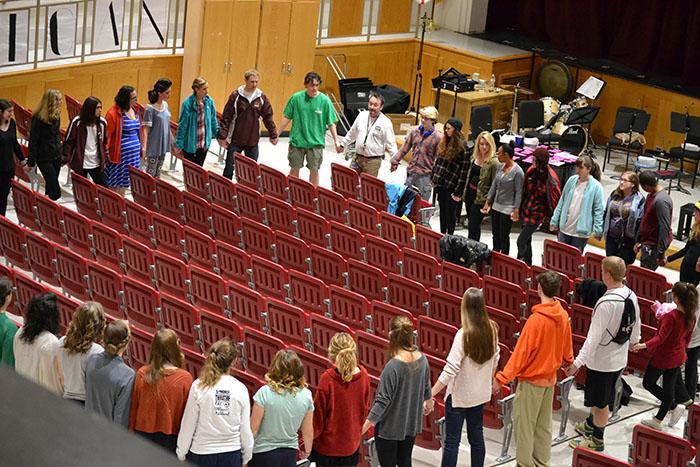
The “Anything Goes” cast and crew participate in the “pulse,” joining hands in the auditorium before the show.
The pulse is an “a transmission of energy,” Rose said. “I just start it with my hands, and we just pass it around two ways so it goes all the way around the circle. . . Everyone feels connected to each other.”
While their hands are linked, Rose tells the cast and crew that “they’re creating a memory that will last the rest of their lives. I want everyone to have the energy to make that memory happen.”
Once all linked hands have gently squeezed each other, and the pulse has made its full round, the circle breaks and everyone gets to work.
There are five crews that contribute to the running of the show: house, lights, costume, sound, and stage.
House
House crew is responsible for everything outside of the auditorium. Before the doors open, the crew sets up tables for tickets in the hall and for refreshments in the auditorium lobby, as well as chairs in the lobby “so people can chill before the show,” house crew member Michael Anthony (’18) said. “Sales, set-up, and clean-up,” he said, are the crew’s main responsibilities. “House crew is pretty simple, an open book, essentially.”
Lights
Lights crew is a little more complex. Controlled from the lights booth in the balcony of the auditorium, the light sequence for the show is programmed and in the computer even before Tech Week – a week of late-night rehearsals directly preceding opening night.
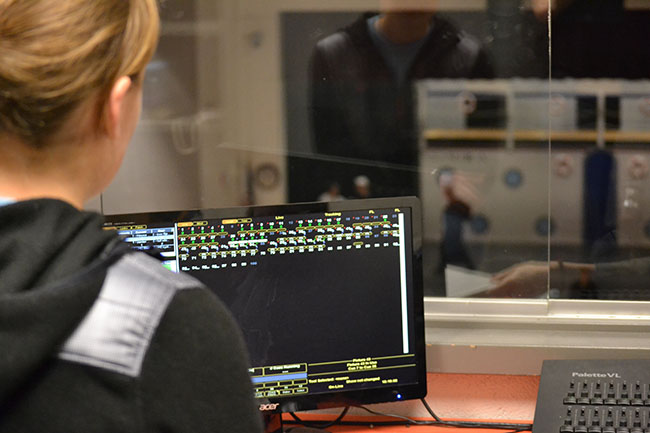
Light crew member Elizabeth Thompson (’19) surveys the stage from the lights booth, located up in the balcony of the auditorium.
Elise Burr (’17) and Meghan Gorsuch (’17), heads of lights crew, “pre-set and program all the lights for different colors, where they are, positioning, and all that,” Burr said. From there it’s a matter of pushing buttons.
Of course, that’s not to say that things can’t go wrong. “The day before the show, the lights system just shut down,” Burr said. “The computer wouldn’t click buttons and the board wouldn’t respond.” The crew had to quickly program the lights all over again.
While the show is running, lights crew communicates by headset with Stage Manager Sarah Durst (’17), who tells them when to blackout and come back on again. This communication is crucial, as lights need to coincide with sound and accommodate for costume changes.
“Sometimes the actors take three minutes, sometimes they take two minutes,” Burr said. Lighting up the stage while the actors are still changing costumes would cause a delay.
Costume
Some actors and actresses have several costumes for each show. Lead actress Marcy Ledvinka (’17) had eleven different outfits for “Anything Goes,” and changing costumes between scenes required practice.
Costume crew members are the only backstage crew members to be with the actors and actresses from the first day of rehearsal to the last night of the show. They spend a lot of time practicing “quick changes.”
Costume crew member Callie Simon (’17) said, “We have to make spreadsheets, we have to practice, we have to coordinate which side we need to be on, moving, switching, who does what, who takes pants off, who puts the shirt on … everything has to be planned out far in advance.” There’s more to an actor’s wardrobe than you might think.
“If a lead comes off, and she needs to be back on in twenty seconds, and she needs a whole dress changed, there are like five people on her,” Durst said. “There’s definitely a lot of craziness backstage.”
Costume crew doesn’t exist only onstage, however. The creation of a character’s look begins downstairs, beneath the stage in the dressing room.
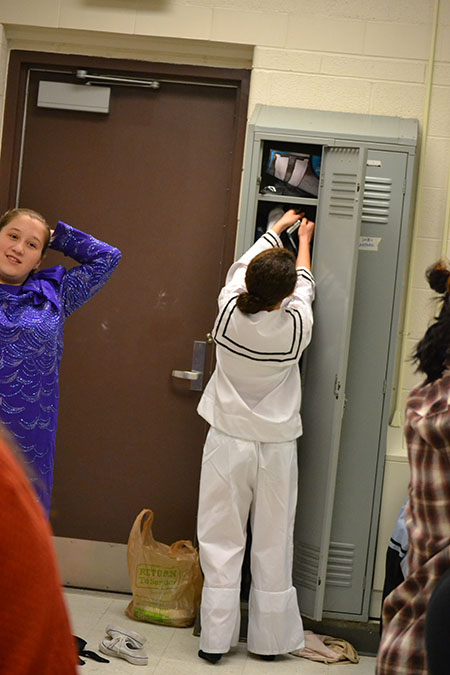
Caroline Dias (’18) stores a bag in her locker in the dressing room, located beneath the stage. Actors and actresses sometimes share lockers. “Sometimes you’re partnered up with someone if you have a role that correlates to theirs,” Dias said, “but a lot of the time the leads with a lot of costumes get their own locker.”
Lockers house costumes, makeup, and other theatrical necessities.
On a show night, hair flies through crew members’ fingers, and there is makeup everywhere, perhaps most surprisingly on the boys’ faces. Simon told me that all the guys had to be turned into Doritos.

Callie Simon (’17), a member of the costume crew, applies a thick layer of foundation to actor Ben Turek’s (’17) face. Because of the bright lighting on stage, “all the guys get turned into Doritos,” Simon said.
“With all the bright lights hitting their faces, they get very washed out,” she said. “So in order to compensate for that, you need to put a lot of darker, tan makeup on them so that they can still be seen.” Eyes and eyebrows are also darkened, because “you’ve got to be able to see those features,” Simon said.
Specialty makeup, required when making an actor look elderly, is also applied liberally. Costume crew member Grace Ebacher-Rini (’17) said, “You really have to make the lines really dark.”
Davis Guyton (’20) had to undergo such a transformation. They made dark lines around his eyes, around his mouth, and on his forehead. “They put it all over my face,” he said. “They made me look like I had a lot of lines.”
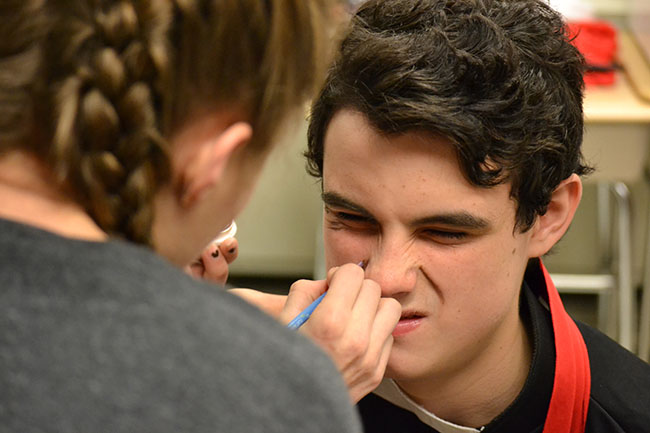
Davis Guyton (’20) is transformed into an old man by Grace Ebacher-Rini (’17), a member of the costume crew.
And where do the costumes themselves actually come from?
The “dungeon,” a Cold War bomb shelter located beneath the stage. It is full of costumes, and “a bunch of them are not even wearable,” Ebacher-Rini said. There are “piles and piles,” she said. “You can barely walk. I’m not kidding.”
“It smells like cat pee down there,” Simon said. “It’s really awful.”
A lot of what the actors wear comes from this dungeon. Much of it has been donated, and some of it comes from Goodwill.
“A lot of people don’t know that we use a lot of stuff again,” Ebacher-Rini said. “Some of it we can alter, and some of it we make ourselves, but a lot of it is donated.”
Sound
Once actors and actresses are in costume and makeup, they return to the auditorium to be “miked.” Microphones are given to “leads, and almost anyone who has a line,” sound crew member August Bubier (’19) said, “unless they only have like one line.”
There are several ways to go about connecting an actor or actresses’ voice to the sound system, according to costume and role. “Dancers, or people who move around a lot, they get [the mic] taped on their face,” Bubier said. “People who just have some lines, and they’re not moving around a lot, they can get it clipped on them. It’s easier, and they’re not dancing so it won’t fall off.”
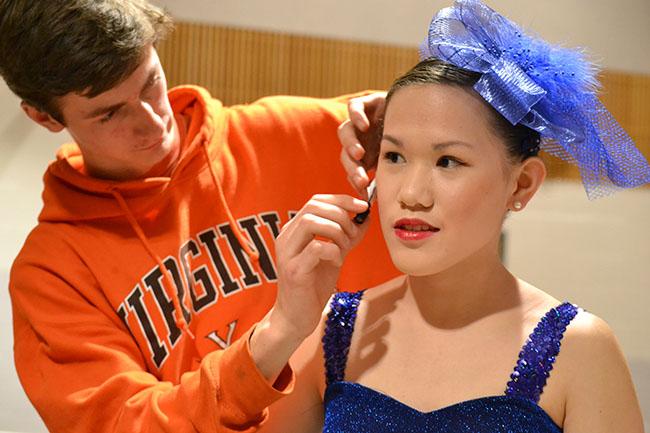
August Bubier (’19), a member of the sound crew, mikes Dance Captain Katelyn Dixon (’19).
Some actors and actresses are exceptions to the general mic routine. Ledvinka, because she had so many costume changes and dances to participate in as a lead, had her mic clipped to her hair and put down her forehead, the wires coming down her neck and back. “Her wig concealed it,” Bubier said.
Lead Tony Cabral (’17) was another exception. “He had a belt that held it,” Bubier said. “That way, it’s easier for costume changes.”
When everyone has been miked in one way or another, it’s time for “sound check.”
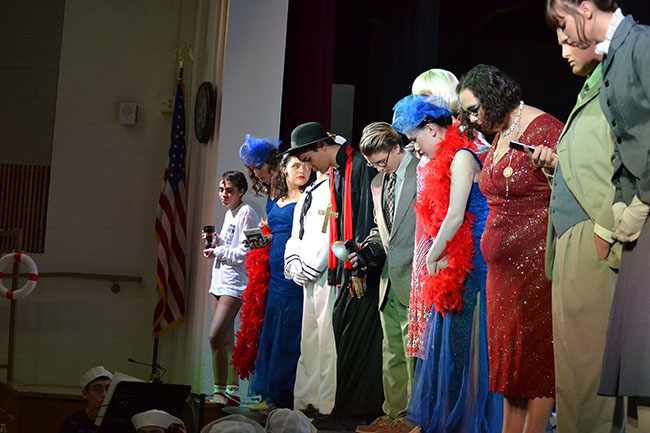
Miked cast members line up on stage for sound check.
“Sound check is when everyone who has a mic lines up,” Bubier said, “and you have them just talk for a while.” As they speak from onstage, Bubier, who mans the sound board at the back of the auditorium, makes slight adjustments with the equalizer to “make sure it sounds good and it’s loud enough.”
Stage
Stage crew, under the close direction of Durst and her co-Stage Manager Keegan Brush (’17), is primarily responsible for props, curtains, and set. For “Anything Goes” Durst remained consistently on headset, controlling lights and sound, while Brush commanded the movement and placement of props and set pieces. Taped on a wall backstage are diagrams laying out the complete set for each individual scene of the show.
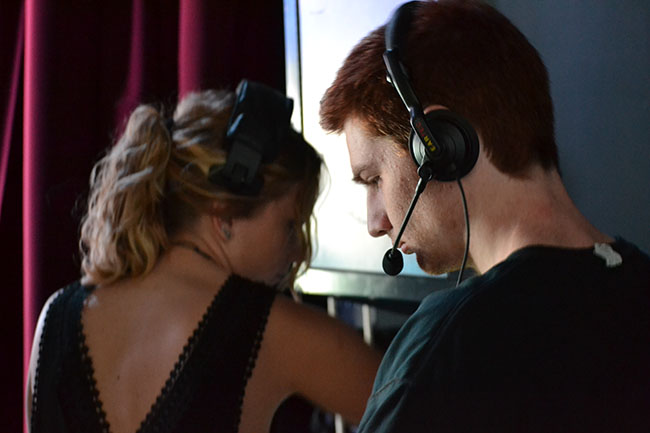
Stage Managers Sarah Durst (’17) and Keegan Brush (’17) communicate by headset with lights and sound crews.
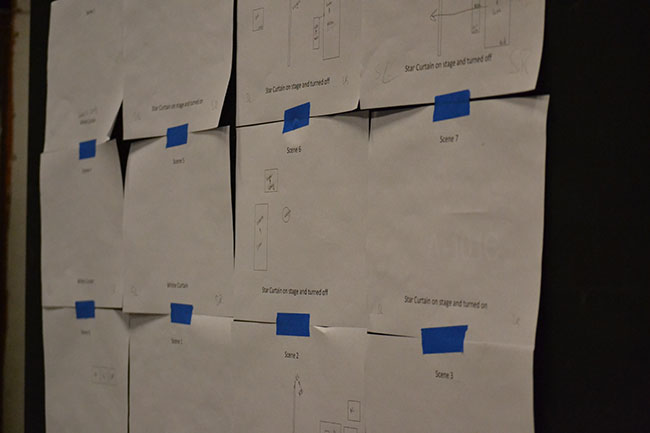
Diagrams of stage and set layout for each individual scene are taped to a wall backstage. “Sarah [Durst] (’17) designed all those papers with each scene, the curtain that had to be on, what the stage looked like, stage right, stage left,” Keegan Brush (’17) said. The diagrams were posted on both sides of the stage for the convenience of stage crew members.
But wait! There’s more.
There’s more to the behind the scenes of theatre than these five crews alone. The Pit Orchestra and dance also play vital roles in the making of a musical.
Pit Orchestra
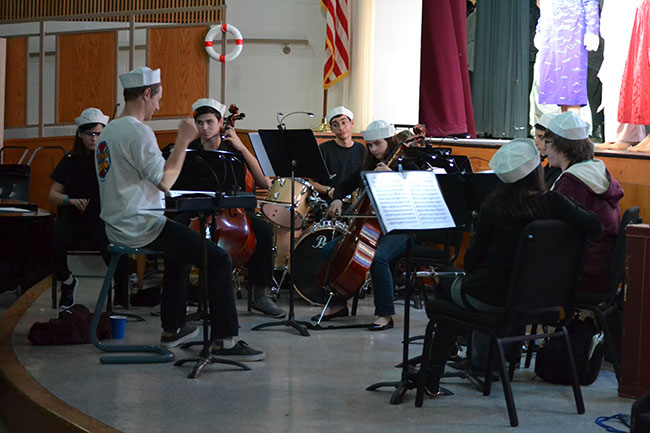
The Pit Orchestra, directed by Choir and Guitar teacher David Sobel, accompanies the actors and actresses onstage.
The Pit Orchestra is the small group of instrumentalists located beneath the stage – in the pit – who “accompany the singers, actors, and dancers as they are onstage,” said Sobel, who directs the orchestra. “The Pit’s purpose is to provide support and accompaniment without being visually disrupting.”
Pit Orchestra begins rehearsal long before dances have been learned and costumes are made. “Just as the singers and dancers rehearse daily, in specific arrangements and with a specific schedule, we do the same,” Sobel said. “We learn in small chunks, piece by piece at a time, slowly combining and reviewing music as we go.”
“Anything Goes” featured big band jazz music, scored for trumpets, saxophones, and trombones, although Hereford’s small pit only included a couple of saxes, a flute, a cello, a violin, and a piano.
During intermission of the last night of the show, while audience members stretch and visit the concession stand, the musicians begin vigorously erasing the markings from their sheet music.
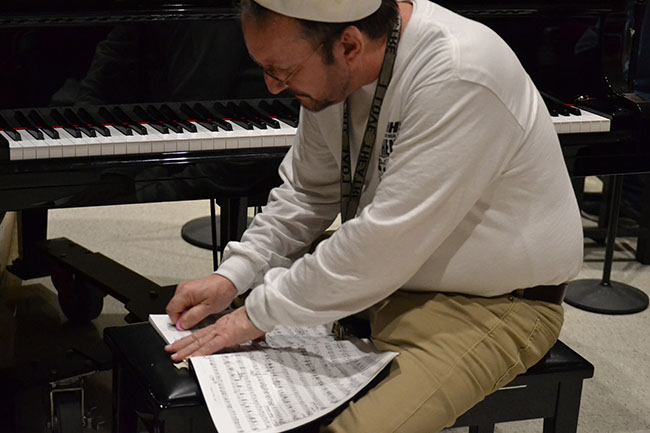
Fine and Performing Arts Department Chair Chris Rose erases the markings from his sheet music during intermission.
“We erase all of our score markings at the end because the company that we rent out the music from requires that we get it back immediately,” Sobel said, due to financial obligations and penalties. Erasing those marks also helps the next musicians to use the scores without confusion.
“Say I’m the conductor, and I write in all of my notes,” Sobel said, “but the next conductor that uses the same exact score, who rents that score, is going to have those notes and is going to get confused and it’s not going to be a clean text. They’re going to complain to the publishing company that the book isn’t clean.”
Dance
A musical wouldn’t be a musical without dancing. That’s where Dance Captain Katelyn Dixon (’19) comes in.
“As the Dance Captain, my job is to relay the choreography that [Dance teacher Erin Norton] has choreographed,” Dixon said. “I was in charge of meeting with the people after school on Monday and Thursday to teach them the choreography, stage it, and really make sure that everybody had a good handle on it. I also helped people during Enrichment.”
Dances took hours to perfect, and often more than one dance was being rehearsed simultaneously, both on and off stage. “We found different ways to make it work,” Dixon said. “It helped to utilize our new studio with the mirrors, so everyone could really see.”
“Anything Goes” featured two full-cast dances, five others performed by the shows casted “angels,” and still others by some of the leads.
Leads’ dances, which may only include two or three cast members, are choreographed separately from the rest. “They worked on those alone with Mr. Rose,” Dixon said.
This particular show presented some challenges in the form of tap. “No one really had that much experience, so it was definitely harder,” Dixon said, “but everyone really worked for it.”
Before the curtain closes
Aside from all of this – these many secrets and magic tricks that have made a show – the theatre holds other secrets unbeknownst to those who haven’t crept backstage. Did you know that there is a piece of Styrofoam taped over the latch of a door backstage to keep it from slamming during the show? Did you know that during intermission the cast and crew play cards and eat snacks? Did you know that the seniors join hands in their own circle the last night of the show to share their memories, feelings, and tears? Did you know that those seniors sign the walls with their names before they leave the stage where they learned the magic of theatre?
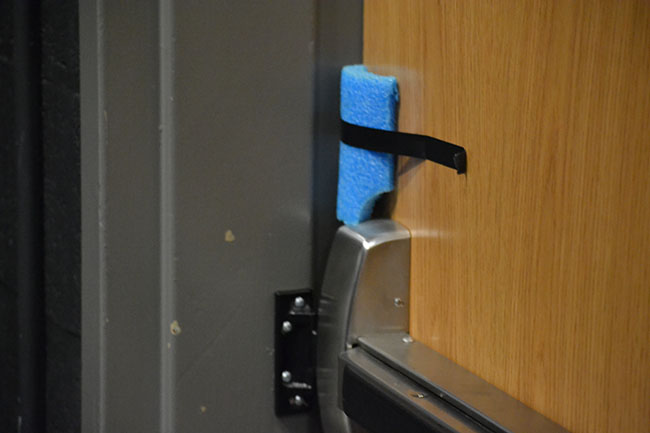
A piece of blue Styrofoam is taped to a door backstage. It is meant to prevent the door, through which actors and actresses enter from the dressing room, from slamming during shows.
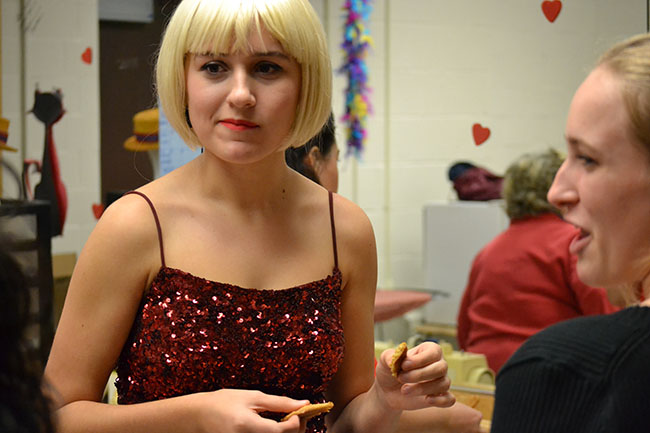
Lead actress Rachel Larkin (’17) munches on a cookie in the dressing room during intermission. When the audience stood to stretch and visit the concession stand, cast members found a snack, too.
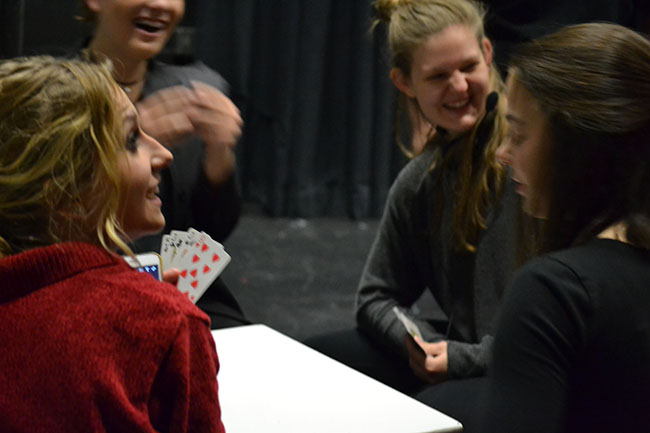
Stage crew members enjoy a game of cards during intermission. Stage Manager Keegan Brush (’17) started the card game culture backstage. “During the show we use a little box of cards as cigarettes,” Brush said. He didn’t see them as cigarettes, however, and rightly so.
“Before every show,” he said, “I would play solitaire by myself . . . and during intermission we’d get a couple kids together and we’d play BS or Spoons, but we didn’t have spoons so we’d use shoes. It was pretty fun.”
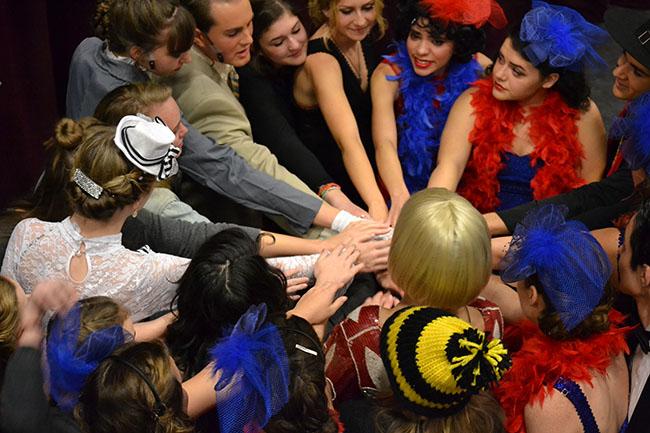
Senior cast and crew members gather for one last cheer before the curtains open, a tradition known as the “senior circle.”
“It’s a ceremonial ritual that all the seniors do at their last big show,” lead actor Tony Cabral (’17) said. “We talked about reflections on past shows, how it’s been an honor and a pleasure to be with one another for so long, what it’s felt like, and who we want to thank, and honor, and tip our hat to.”
There’s more to Hereford’s theatre department than first meets the eye. “It doesn’t just happen,” Sobel said. Perhaps that is theatre’s biggest secret.
DVDs of “Anything Goes” are now available, priced at $20.
Rose also encourages more students to get involved in Hereford’s shows. “We need tech people,” he said. “We need people that want to learn lights, people that want to learn sound, people that want to work on set building that are willing to give time.” Go help make the magic happen.


